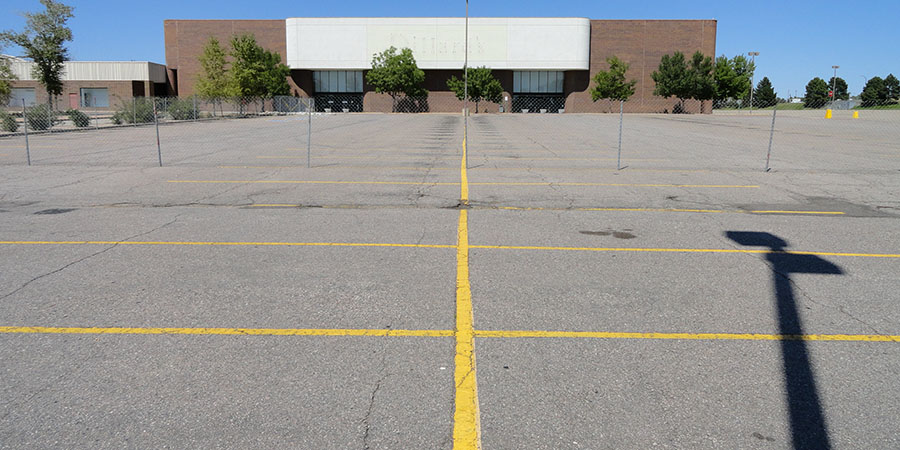
(Photo: JohnGiez/Flickr)
An equitable recovery from the COVID-19 pandemic for all Californians will require the use of new governance structures and financial tools that can provide the fiscal resources and coordination necessary to support resilient economic growth throughout the state.
CA FWD’s Increasing Community Investment policy work group has focused their efforts over the past year on spurring immediate economic stimulus by advocating for tools to fund housing and infrastructure. The revitalization of commercial retail properties and malls – many of which are underutilized or expected to close in the next few years due to the changing nature of retail, including a shift from store front to online shopping – presents an opportunity for the use of Enhanced Infrastructure Financing Districts (EIFDs) to support the redevelopment of these sites for housing and other public amenities.
A recent study from UC Berkeley’s Terner Center found a significant amount of land designated for commercial use throughout the state, with most of that land set aside for retail purposes. According to Kosmont Companies, a firm that specializes in economic development transactions, California has an estimated 200 regional malls and even more shopping centers on thousands of acres in prime locations: large, highly visible sites, near freeways and on high-traffic arterials, transit-oriented and typically not adjacent to single family neighborhoods.
The reality is that a retail center will not be just retail anymore. “In an increasingly digital delivery-based economy, these large ‘A’ located sites, must transition to blended use destinations that include daily attractors such as education, events, food, services and medical in addition to on-site residential ‘roof tops’ that provide a captive user audience,” said Larry Kosmont, a lead of the Increasing Community Investment work group and chairman and CEO of Kosmont Companies. “The new metric is ‘trips per square foot’ as a determinant of sales per square foot.”
Repurposing these sites for housing and other public amenities would serve the needs of local communities and align with the state’s environmental goals by situating new development in prime locations near existing transit corridors. However, the state’s attempt at legislative solutions to facilitate this repurposing cannot be successful until an underlying issue is addressed, which is the ability of major anchor tenants to exert near total control over the negotiation process due to legacy restrictive agreements in place that require unanimous consent to changes in how these properties are used. Anchor tenants refers to the larger retailers with widespread name recognition and broad-based appeal that have traditionally served as the key attraction that draws the public to a given shopping center.
Restrictive agreements known as COREAs (Construction, Operation and Reciprocal Easement Agreements) are typically recorded and require unanimous approval by property owners and/or retail anchor tenants on any modification to the site’s uses, parking, and expansion. During retail mall expansion years, COREAs were the “glue” that allowed malls to be financed and developed; today this “glue” is clogging up the pathway to reuse.
Resolving the COREA roadblocks and unlocking the potential of underutilized retail sites throughout the state is possible through the existing mechanism of Enhanced Infrastructure Financing Districts (EIFDs). EIFDs are an economic development tool that allows local governments to pay for projects like affordable housing, transit, parks and libraries, and sustainable infrastructure using future property tax revenues arising from an expected increase in the value of the land resulting from the improvement projects the EIFDs financed.
EIFDs have been championed by the California Economic Summit and the Increasing Community Investment work group as a tool that not only provides financing for critical infrastructure improvements but is a mechanism for bringing different levels of government and the private sector together to work collaboratively on projects of regional importance.
The California Forward Action Fund is sponsoring legislation to enable EIFDs to help resolve the COREAs issue. SB 696, introduced by Senator Ben Allen (D-Santa Monica), would allow EIFDs and their boards, also known as Public Financing Agencies (PFAs), to be granted the ability to vacate the restrictive COREAs if the land occupied by the retail sites in question address a specific public need that aligns with the intended purpose of an EIFD.
“As the state addresses the fallout from the pandemic and Californians adapt to a post-COVID world with changing patterns of commuting and shopping, reimagining underutilized retail sites presents an exciting opportunity,” said Senator Allen. “Our bill will help ease the transition of these sites if that’s what local communities want.”
While in past decades, COREAs were the agreements that protected retail and their oversized parking lots, they are now the obstacle to delivering reimagined, blended-use centers bolstered by improved infrastructure, public amenities, outdoor family attractions, housing and transit connections. The problem is that many regional centers have multiple landowners including the department store anchors and the interior mall owner, all with different motivations in an imploding storefront world. Kosmont points out that “these owners have different exit strategies, time frames and priorities and they are holding each other hostage based on their respective COREA veto rights in essence, the glue that originally made these centers financeable centers, is now too sticky to facilitate revitalization and reuse.” SB696 would compel collaboration on a timelier basis.
As a result, EIFDs, if given the capacity to unlock these seemingly invincible COREAs, offer a timely and productive path forward that will ensure community needs and priorities are at the center of changes largely driven by a digitally infused post-COVID economy.

